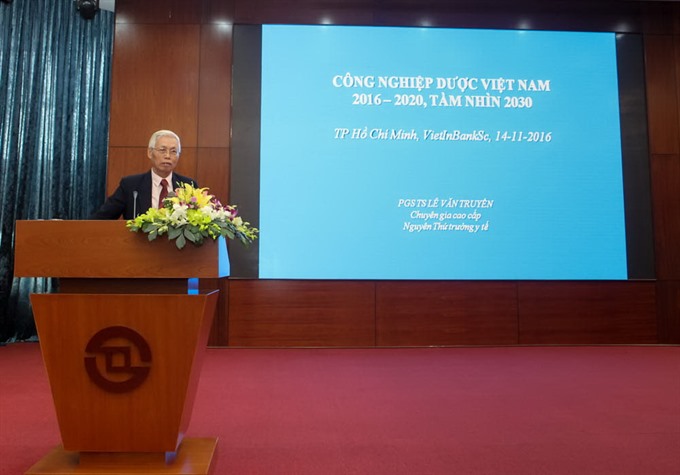 Economy
Economy

Việt Nam’s pharmaceutical sector has tremendous potential for growth, its numerous structural weaknesses notwithstanding, a seminar heard in HCM City on Monday.
 |
| Assoc Prof Dr Lê Văn Truyền, a former deputy health minister, said Việt Nam’s pharmaceutical sector has tremendous potential for growth. — VNS Photo Xuân Hương |
HCM CITY — Việt Nam’s pharmaceutical sector has tremendous potential for growth, its numerous structural weaknesses notwithstanding, experts say.
Lê Văn Truyền, a former deputy health minister, told a seminar in HCM City on Monday that the country’s drug market had expanded at 17-20 per cent a year in 2010-15, the 17th fastest growth rate in the world.
It is expected to maintain a growth rate of over 17 per cent next year, he said.
According to the Việt Nam Industry Research and Consultant, per capita drug consumption was worth US$4.2 billion last year, double the 2010 figure.
“Việt Nam is considered an emerging market (Pharmerging). Currently, there is a big difference in per capita consumption between developed and emerging countries ($609 versus $91), which means that Việt Nam’s pharmaceutical market has more room to grow,” he said.
Domestic production met only 45 per cent of demand last year, and the country had to import a large volume of products, he said.
"Local producers import 90 per cent of raw materials they need for drug production. But they focus mainly on generic drugs, with very low expenditure on R&D," he said.
Despite challenges, the country’s growing population, heightened health awareness among the middle class, and the Government’s policy to develop the industry provide ample stimulus for growth, according to Truyền.
Besides, with costs increasing in developed countries, many multinational drug companies are looking for co-operation with Vietnamese companies to outsource production, with many eyeing stakes in local companies.
Đặng Trần Hải Đăng, deputy director of research at Vietinbank Securities, said pharmaceutical products are an essential item.
He quoted the Business Monitor International as saying the industry would continue to enjoy double-digit growth of 11.8 per cent for the next five years.
"The industry’s potential is reflected in pharmaceutical stocks, with the sector always topping growth rates and every listed firm seeing an increase in price," he said.
All listed firms achieved good growth in terms of both revenue and profit in the first nine months of this year, he said.
Attractive stocks
For the reasons mentioned above, pharmaceutical stocks have remained attractive to investors though most of the listed firms have run out of room for foreign ownership.
Of the 15 listed pharmaceutical companies, only Domesco Medical Import Export Corporation (DMC) in September removed its limit on foreign ownership while the others, including DHG Pharmaceutical JSC (DHG) and Traphaco JSC (TRA) are yet to make any decisions.
Foreign investors now own 51.7 per cent of DMC, and less than 49 per cent in the other two firms.
Foreign investors’ expectations have boosted these companies’ stocks since Decree 60/2015/NĐ-CP was issued in June 2015, allowing the removal of foreign ownership limits in listed companies. The stocks have gone up by 70 per cent in the last 12 months.
Trần Hải Đăng, an analyst with VietinbankSC, said three main factors determine how attractive a pharmaceutical stock is.
The first one is strong financial status, which is illustrated by high stable growth, and a reasonable lending ratio.
The reputation of a company and its experience in the market, positive reviews and feedback on its products and an efficient distribution network are also determinants.
The third factor is the development potential of a firm marked by its R&D investments, improved production, and co-operation plans with overseas firms that are experienced, technologically advanced and rich in capital resources.
Đăng also said that the average price-to-earnings ratio (P/E) for all listed drug companies is now 14.21, lower than an average P/E ratio of more than 20 other companies in the region, making local stocks quite attractive to investors.
Organised by VietinBankSc, the HCM Stock Exchange and Traphaco JSC, Monday’s seminar aimed to help investors understand the industry better and make the right investment decisions.
As of last year, the country had 150 pharmaceutical plants meeting WHO-GMP standards and three domestic and several foreign factories meeting PIC/S-GMP and EU-GMP standards, Truyền said, adding that many drug makers have been building new plants meeting such quality standards. — VNS




